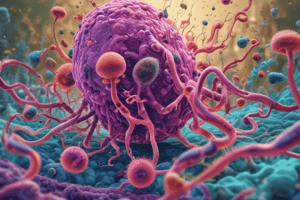Podcast
Questions and Answers
What is the primary effect of increased intracellular cAMP levels in the context of cholera?
What is the primary effect of increased intracellular cAMP levels in the context of cholera?
- Inhibition of Na+, K+, and Cl– ion reabsorption (correct)
- Increased absorption of water in the intestines
- Stimulation of Na+, K+, and Cl– ion reabsorption
- Inhibition of fluid secretion into the intestine
What is characterized by the term 'rice water stool' in cholera?
What is characterized by the term 'rice water stool' in cholera?
- Increased bile salts in stool
- Presence of blood and pus in stool
- Stringy mucus without fluid
- Fluid that is isotonic with plasma with higher sodium and potassium (correct)
Which clinical finding is NOT typically associated with cholera?
Which clinical finding is NOT typically associated with cholera?
- Profuse diarrhea
- Consistent fever (correct)
- Severe dehydration
- Abdominal cramps
What is the recommended treatment for dehydration caused by cholera?
What is the recommended treatment for dehydration caused by cholera?
Which of the following is an ineffective prevention method for cholera?
Which of the following is an ineffective prevention method for cholera?
What shape do Vibrio cholerae bacteria have?
What shape do Vibrio cholerae bacteria have?
Which pathway primarily transmits Vibrio cholerae?
Which pathway primarily transmits Vibrio cholerae?
What is the main virulence factor produced by Vibrio cholerae?
What is the main virulence factor produced by Vibrio cholerae?
What is the role of the A1 subunit in cholera toxin's mechanism of action?
What is the role of the A1 subunit in cholera toxin's mechanism of action?
Where do Vibrio cholerae bacteria primarily attach in the human body?
Where do Vibrio cholerae bacteria primarily attach in the human body?
What is a characteristic feature of Vibrio cholerae concerning salt?
What is a characteristic feature of Vibrio cholerae concerning salt?
What is the typical incubation period for a cholera infection?
What is the typical incubation period for a cholera infection?
What happens when the A subunit of cholera toxin dissociates?
What happens when the A subunit of cholera toxin dissociates?
Flashcards
Cholera
Cholera
A condition caused by the bacterium Vibrio cholerae, characterized by severe watery diarrhea, dehydration, and electrolyte imbalance.
Cholera toxin
Cholera toxin
A toxin produced by Vibrio cholerae that increases cAMP levels in intestinal cells, leading to fluid loss and diarrhea.
Rice water stool
Rice water stool
The primary symptom of cholera, characterized by profuse watery diarrhea resembling rice water.
Dehydration in cholera
Dehydration in cholera
Signup and view all the flashcards
Oral rehydration therapy (ORT)
Oral rehydration therapy (ORT)
Signup and view all the flashcards
Vibrio cholerae
Vibrio cholerae
Signup and view all the flashcards
Vibrio cholerae transmission
Vibrio cholerae transmission
Signup and view all the flashcards
Vibrio cholerae pathogenesis
Vibrio cholerae pathogenesis
Signup and view all the flashcards
Adherence and Colonization
Adherence and Colonization
Signup and view all the flashcards
B subunit
B subunit
Signup and view all the flashcards
A1 subunit
A1 subunit
Signup and view all the flashcards
cAMP (cyclic adenosine monophosphate)
cAMP (cyclic adenosine monophosphate)
Signup and view all the flashcards
Study Notes
Vibrio cholerae Overview
- Gram-negative, oxidase-positive, motile rod-shaped bacteria
- Salt-tolerant or salt-requiring
- Found in freshwater ponds and brackish water
- Cultivable on standard stool culture media
- Causes cholera disease
Transmission
- Transmitted by the fecal-oral route (contaminated food/water)
- Large infectious dose required; person-to-person transmission is less common
- Recovered cholera patients can shed the bacteria, acting as reservoirs in endemic areas
Pathogenesis
- Incubation period: 6 hours to 3 days
- Adheres to intestinal microvilli after crossing the stomach acid barrier
- Multiplies, producing potent cholera toxin (enterotoxin)
- Toxin acts on GM1 ganglioside receptors on intestinal cells
- Cholera toxin's A1 subunit activates adenylate cyclase
- Activates adenylate cyclase, increasing intracellular cAMP
- This leads to sodium, potassium, and chloride loss (Hypersecretion of Cl− and HCO3−)
- Water and electrolytes lost in stool (rice-water stool), leading to dehydration, acidosis, and shock
Clinical Findings
- Sudden vomiting
- Profuse watery diarrhea (rice-water stool) with abdominal cramps
- Rapid fluid loss and electrolyte depletion causing dehydration, circulatory collapse, and anuria
- High mortality rate (25-50%) without treatment
Diagnosis
- Stool or vomitus culture
Treatment
- Fluid and electrolyte replacement therapy
- Effective antimicrobial therapies (e.g., oral tetracycline)
Prevention
- Improved public sanitation to reduce fecal contamination of water sources
- Avoiding contaminated food/water
- Boiling drinking water
- Handwashing
- Vaccination is short-term in providing protection.
Studying That Suits You
Use AI to generate personalized quizzes and flashcards to suit your learning preferences.




